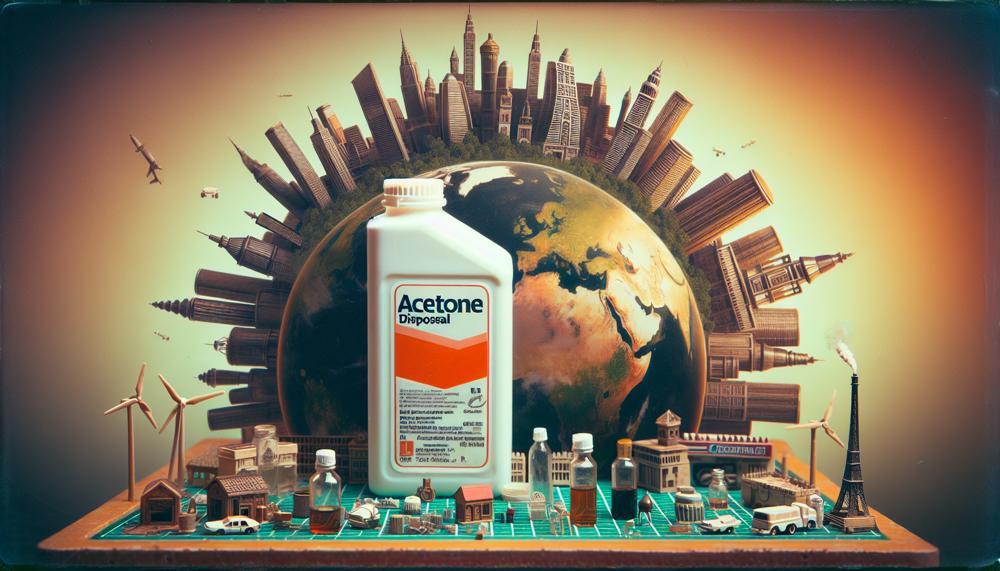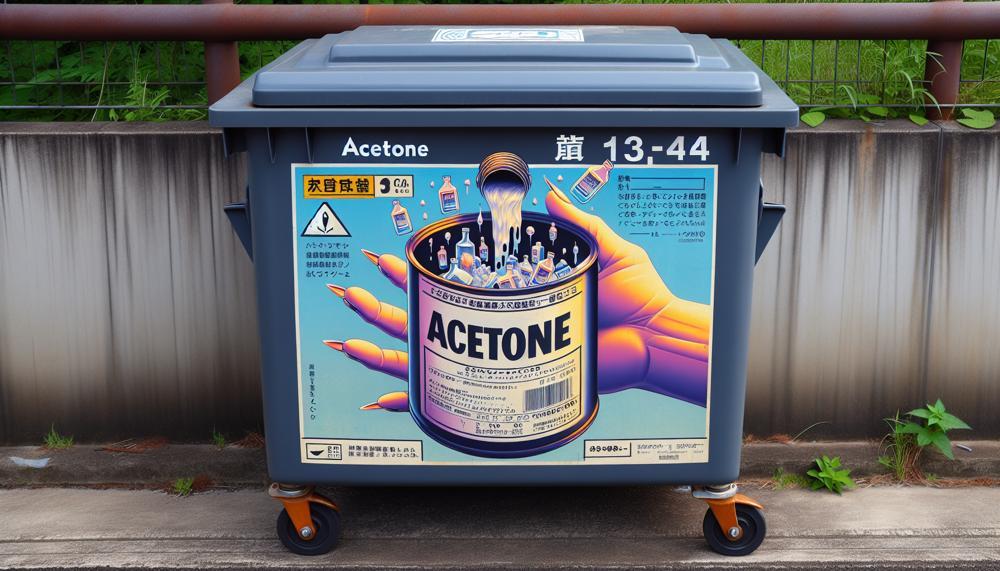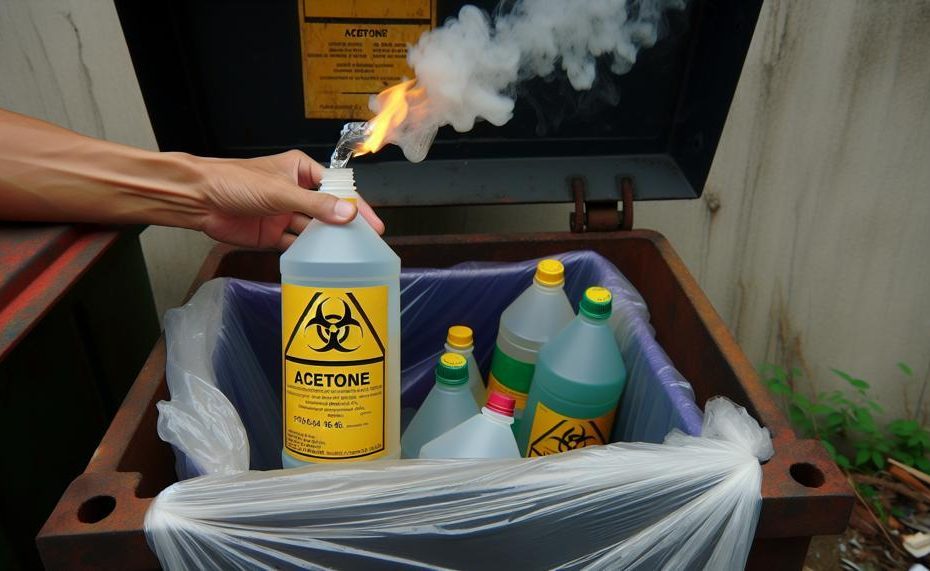Are you tired of constantly worrying about how to safely and responsibly dispose of acetone? We’ve got you covered with all the information you need to say goodbye to this common household chemical without any harm or hassle.
Acetone may seem harmless, but it’s actually a highly flammable and potentially hazardous substance that requires careful handling. So before you go tossing it in the trash or down the drain, here are a few important steps you need to take:
First things first, check with your local waste management agency for specific guidelines and regulations on disposing of chemicals. Each area may have different rules, so it’s always best to double-check.
If your area offers household hazardous waste collection, consider yourself lucky. This is the safest and most convenient option for getting rid of acetone. Simply pack it up in a sealed container and drop it off at the designated location.
But if your area doesn’t offer this service, don’t worry. You can still dispose of acetone properly by mixing it with an absorbent material like cat litter or sawdust before sealing it in a container and throwing it away with your regular trash.
Just remember, never pour acetone down the drain or onto the ground. It can contaminate water sources and harm the environment. And always protect yourself by wearing gloves and eyewear when handling this chemical.
Now that you know how to handle acetone like a pro, go ahead and tackle those DIY projects without any worries. Your safety and that of our planet is in good hands.
Contents
- 1 Key Takeaways
- 2 Understand the Hazards of Acetone
- 3 Check Local Regulations and Guidelines
- 4 Consider Reusing or Recycling
- 5 Use a Chemical Disposal Facility
- 6 Seal and Label the Container
- 7 Store and Transport Safely
- 8 Seek Professional Assistance
- 9 Dispose of Small Amounts in Household Waste
- 10 Educate Yourself and Others
- 11 Conclusion
Key Takeaways
The main takeaways for safely disposing of acetone are:
| Disposal Method | It is crucial to choose the appropriate disposal method depending on the amount of acetone. If you only have a small quantity, it can be disposed of with regular household waste. However, larger amounts require drop-off at a hazardous waste recycling facility. |
| Safety Measures | Always prioritize your safety by wearing protective gear like gloves and masks when handling acetone. Never pour it down the drain or mix it with other chemicals. To avoid confusion with other substances, ensure that reused acetone is properly labeled. |
| Environmental Responsibility | By recycling spent acetone, we can reduce waste and demonstrate environmental responsibility for both individuals and businesses. |
| Local Regulations | It is crucial to follow local regulations for hazardous waste disposal when getting rid of acetone. This not only ensures proper management but also protects human health and the environment. |
In essence, disposing of acetone requires careful consideration of potential risks and adherence to safety measures. By following the correct disposal methods and regulations, we can ensure safety while also playing our part in preserving the planet.
Understand the Hazards of Acetone
Acetone can pose a variety of potential hazards to both human health and the environment due to its flammable and toxic properties, as well as its potential for causing pollution.
To ensure safe disposal of acetone, it is crucial to properly store it, utilize services for acetone recycling, or allow it to evaporate in a well-ventilated area.
By following these steps, we can effectively minimize the risks associated with using acetone and contribute to a safer and healthier environment for all.
| Potential Hazards | Safety Measures |
|---|---|
| Flammability | It is important to handle acetone with extreme caution and keep it away from any sources of ignition. |
| Toxicity | It is crucial to use protective gear when handling acetone and avoid ingesting or inhaling its strong vapors. |
| Environmental pollution | To prevent environmental pollution, it is essential to dispose of acetone properly by utilizing recycling services or contacting hazardous waste facilities. |
| Safe Disposal Methods: | |
| Store unused acetone in a tightly sealed container. | |
| Contact your local household hazardous waste facility for proper disposal. | |
| Utilize an acetone recycling service for safe disposal. | |
| Allow the acetone to evaporate in a well-ventilated area. | However, be sure to check local regulations before doing so. |

Check Local Regulations and Guidelines
Local Regulations and Guidelines: An Essential Guide
| Country/Region | Regulations/Guidelines | Source |
| United States | – Properly label and store acetone in designated containers – Comply with specific storage time limits – Research and follow state-specific regulations |
– Occupational Safety and Health Administration (OSHA) – Environmental Protection Agency (EPA) |
| European Union | – Adhere to hazardous waste codes listed in the European Waste Catalogue (EWC) | European Union Waste Framework Directive |
| Canada | – Transport hazardous waste, including acetone, according to the Transportation of Dangerous Goods Act | Transport Canada |
Navigating through regulations and guidelines can be a daunting task, especially when dealing with hazardous materials. It is crucial to stay informed and compliant to protect not only yourself but also those around you. Here is a brief overview of the regulations and guidelines for storing and handling acetone in different regions.
United States:
- Proper storage of acetone is essential. Be sure to label and store it in designated containers to avoid any potential hazards.
- Each state has its own specific regulations regarding the storage of acetone. Make sure to research and follow them accordingly.
- There are also specific time limits for how long acetone can be stored. Be sure to comply with these limits to ensure a safe working environment.
European Union:
- The European Waste Catalogue (EWC) lists hazardous waste codes that must be followed when handling acetone in the EU.
- Adhering to these codes is crucial as it helps ensure proper disposal and prevents harm to the environment.
Canada:
- Transporting hazardous waste, including acetone, is regulated under the Transportation of Dangerous Goods Act in Canada.
- This act outlines specific guidelines and procedures that must be followed to ensure safe transportation of hazardous materials.
So, it is essential to always stay updated on local regulations and guidelines when handling hazardous materials like acetone.
Failure to comply can lead to serious consequences, not just for yourself but also for the environment and those around you.
Consider Reusing or Recycling
Acetone, a commonly used solvent in various industries, can have a significant impact on the environment if not disposed of properly. Here are some responsible ways to dispose of acetone and even find ways to reuse or recycle it.
- Contact your local hazardous waste facility: If you have a large amount of acetone that needs to be disposed of, it is best to reach out to your local hazardous waste facility and follow their disposal guidelines. They are trained to handle hazardous materials and will ensure that the acetone is disposed of safely.
- Use an absorbent material: For smaller amounts of acetone, you can pour it onto an absorbent material like cat litter or sawdust. Once the acetone has been absorbed, place the material in a sealed container and dispose of it according to your local regulations for hazardous waste.
- Create chalkboard paint by mixing with paint: If you have leftover acetone from a project, you can mix it with paint in a 1:8 ratio to create chalkboard paint. This is a fun and creative way to repurpose the acetone and add some color to your walls.
- Donate to neighbors or local businesses: Another option for disposing of small amounts of acetone is to ask your neighbors or local businesses if they need any for their projects. This way, the acetone can be reused, reducing its impact on the environment.
- Recycle at designated facilities: Acetone can be recycled at designated facilities that specialize in handling hazardous materials. These facilities will properly dispose of the acetone or recycle it for future use.
| Method | Quantity | Disposal Instructions |
| Throw in the trash | Small amounts (contaminated rags or cotton balls) | Place in a sealed plastic container before disposing of it in your regular household trash. |
| Contact your local hazardous waste facility | Large quantities | Contact your local hazardous waste facility for proper disposal guidelines. |
| Mix with an absorbent material | Small quantities | Pour onto an absorbent material, seal in a container, and dispose of it following local hazardous waste regulations. |
| Mix with paint | Leftover from a project | Mix with paint to create chalkboard paint and add some color to your walls. |
| Donate to neighbors or local businesses | Small quantities | Ask if anyone needs acetone for their projects to avoid waste and promote reuse. |
| Recycle at designated facilities | Any quantity |
Use a Chemical Disposal Facility
A specialized facility called a chemical disposal facility is responsible for the safe disposal of hazardous waste materials. This facility must strictly adhere to guidelines set by the EPA in order to ensure proper disposal. One common use of this type of facility is to dispose of acetone, a highly flammable and volatile chemical.
At the chemical disposal facility, acetone is carefully collected and stored in appropriate containers before being treated using specialized techniques such as incineration. This process is essential in preventing pollution and safeguarding the public’s health by ensuring that hazardous waste is not illegally dumped or disposed of in ways that could harm communities and the environment.
To properly dispose of acetone, both individuals and businesses can utilize a chemical disposal facility while also following all regulations and guidelines set by the EPA.
In fact, it’s important to remember that improper disposal of hazardous waste can have serious consequences. For instance, if acetone is poured down the drain or dumped illegally, it can seep into the ground and contaminate water sources. This can have a devastating impact on our environment and pose significant health risks to both humans and wildlife.

That’s why utilizing a chemical disposal facility is crucial. Not only does it ensure proper disposal of hazardous waste materials like acetone, but it also helps prevent pollution and protect public health.
By following strict regulations and guidelines set by the EPA, we can work towards creating a cleaner and safer environment for everyone.
Seal and Label the Container
Properly disposing of acetone is imperative for the safety of others and the environment. To do so, it is crucial to seal and label the container effectively. This process involves transferring the acetone into a secure metal container with a tightly sealed lid, using a rubber band or tape to reinforce the seal, and clearly labeling the container with all necessary information.
To further reinforce the seal, you can use a rubber band or tape to secure it in place. Additionally, it is crucial to clearly label the container with all necessary information, including the type of chemical and any warning signs. This will ensure that everyone handling the container is aware of its contents and can handle it safely.
By following these steps, you are not only safeguarding those handling the acetone but also preventing potential hazards to the environment.
Store and Transport Safely
When it comes to safely storing and transporting acetone, it’s essential to follow proper safety measures to avoid potential hazards. These measures include using appropriate containers, storing the chemical away from heat and sunlight, clearly labeling containers, and ensuring secure storage. Let’s take a closer look at each of these safety measures:
- Use Suitable Containers: It is crucial to use the right type of container when storing acetone. Glass, metal, or HDPE plastic containers are the best options as they can resist corrosion and prevent leakage. Avoid using materials like PVC, polycarbonate, or others that can degrade over time and pose a hazardous situation.
- Store Away from Heat and Sunlight: Acetone is highly flammable and can easily ignite when exposed to heat or sunlight. For this reason, it is crucial to store it in a cool, dry place away from any sources of heat or direct sunlight. This will significantly reduce the risk of fire hazards.
- Label Containers Clearly: To ensure the safe handling of acetone, it is essential to label all containers clearly with warning signs indicating that the liquid inside is flammable and can cause harm if inhaled or ingested. This will alert anyone who comes into contact with the container about its potential dangers.
- Avoid Storing Near Food Items: It is important to never store acetone near food items as it can be accidentally ingested if mistaken for another liquid. Make sure to store it in a separate location away from any food items to prevent any potential harm.
- Store in a Secure Location: To prevent any accidental exposure to this harmful chemical, acetone should be stored in a secure location out of reach of children, animals, and uninformed adults.
By following these proper safety measures for storing and transporting acetone, you can ensure the safe handling of this chemical without causing any potential hazards. Always handle acetone with caution and care to prevent any accidents or harm.
Seek Professional Assistance
It is highly recommended to seek professional assistance when disposing of acetone. Professionals, such as hazardous waste management companies, possess the necessary expertise and resources to handle and dispose of hazardous materials like acetone safely. They also have the required permits and licenses to lawfully dispose of these substances.
These experts can provide valuable guidance on how to properly store and transport acetone to prevent any accidents or hazards. Furthermore, they can advise on the appropriate disposal methods for different quantities of acetone, whether it be small amounts or large volumes.
In addition, professionals have access to specialized equipment and tools that are essential for handling and disposing of hazardous materials safely. This ensures that the process is carried out efficiently and effectively, minimizing any potential risks or harm.
Seeking professional assistance for disposing of acetone also plays a crucial role in protecting the environment. Improper disposal of acetone can lead to contamination of water and soil, posing a threat to ecosystems and human health. Hazardous waste management companies have proper procedures in place to ensure that hazardous materials are disposed of in an environmentally friendly manner.
Seeking professional assistance for disposing of acetone not only guarantees safety and compliance with regulations but also aids in preserving the environment. The table below provides a quick overview of the benefits of seeking professional assistance for disposing of acetone:
| Advantages | Explanation |
| Expertise | Hazardous waste management companies possess the necessary knowledge and experience to safely handle and dispose of acetone. |
| Resources | They have access to specialized equipment and tools for efficient and effective disposal. |
| Licenses and Permits | Professionals have the required licenses and permits to lawfully dispose of hazardous materials. |
| Environmental Protection | Proper disposal methods protect the environment from contamination and harm. |
It is highly advisable to seek professional assistance when disposing of acetone. This not only ensures safety and compliance but also contributes to protecting the environment.
Dispose of Small Amounts in Household Waste
While it is true that small quantities of acetone can be safely thrown away in household waste, there are certain precautions that must be taken into consideration. It should be noted, however, that larger amounts of this chemical must be disposed of through hazardous waste facilities or companies. Below are some steps to ensure the safe disposal of small amounts of acetone in household waste:
- Use kitchen roll or tissue to soak up the acetone and place it in a metal bin with a disposable liner. This will prevent any leakage and potential harm.
- Store the metal bin with the acetone-soaked material in a well-ventilated area, away from children, animals, and sources of ignition. This will minimize the risk of accidents.
- Always wear appropriate Personal Protective Equipment (PPE) when handling acetone, including gloves, goggles, and a respirator mask. This will protect you from potential exposure to this chemical.
- Once the acetone has been properly soaked up and sealed in a container, make sure to label it correctly to indicate its contents. This will ensure that anyone handling the waste is aware of its potential hazards.
- Dispose of the sealed container in the designated household waste stream. Be sure to check with your local government for specific guidelines on disposing of hazardous waste.
- If possible, consider reusing or recycling the acetone instead of throwing it away. This can help reduce the amount of hazardous waste being produced and protect the environment.
While it is possible to dispose of small amounts of acetone in household waste, it is crucial to follow proper precautions and guidelines to prevent any potential risks.
Educate Yourself and Others
It is of utmost importance to educate yourself and others on the proper disposal methods of acetone. This hazardous chemical poses a threat to our environment if not disposed of correctly, and can also harm human health if inhaled or ingested.
Improper disposal of acetone can have severe consequences, such as contaminating water sources and contributing to air pollution. This can have detrimental effects on plant and animal life, as well as the overall ecosystem.
As responsible individuals, we must ensure that we are not adding to the degradation of our environment by disposing of hazardous materials like acetone in the correct manner.
Furthermore, understanding how to dispose of acetone properly also helps us comply with regulations and laws. The improper disposal of hazardous waste is considered illegal in many places and can result in hefty fines or legal repercussions.
By educating ourselves and others on the correct disposal methods, we can avoid any legal issues and ensure that we are practicing ethical behaviors.
In addition to environmental protection and compliance with laws, educating ourselves and others on proper acetone disposal can also help reduce the production of hazardous waste.
By reusing or recycling acetone, we can significantly decrease the amount of waste that ends up in landfills or is incinerated, which also contributes to air pollution.
Conclusion
To sum up, the safe disposal of acetone is essential for our own health and the health of our planet.
It is crucial to adhere to proper procedures, such as consulting local regulations, wearing protective gear, and selecting the right disposal method. With these precautions in mind, we can easily bid farewell to this commonly used chemical without any negative consequences.
Always prioritize safety and environmental consciousness by properly sealing and labeling containers, exploring possibilities for reuse or recycling, and utilizing specialized facilities for chemical disposal if needed.





